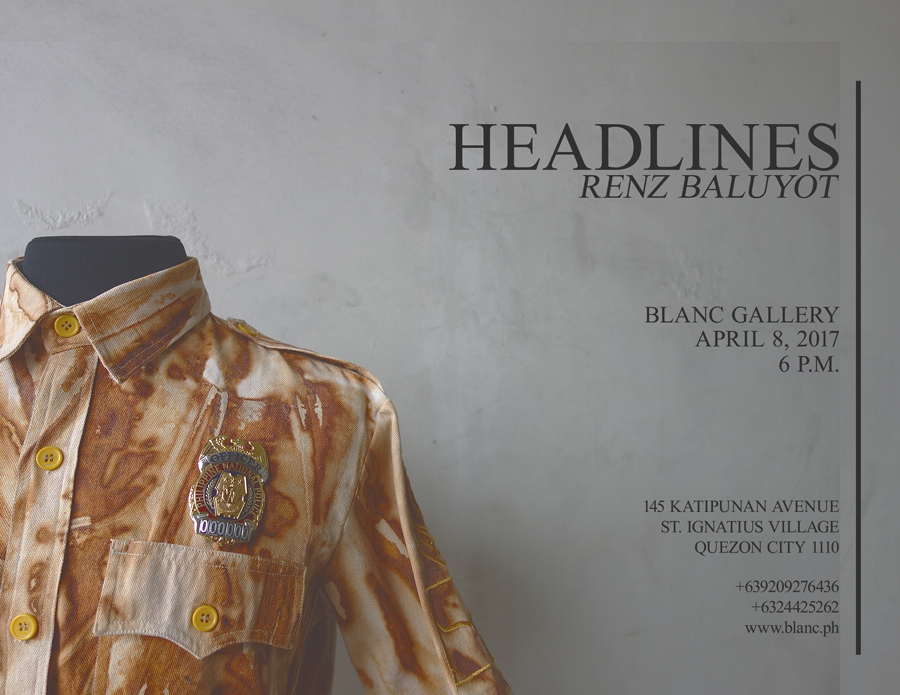
HEADLINES
Renz Baluyot
Blanc Gallery
The shift of global media interest to the Philippines and its urban setting, particularly in the capital region of Metro Manila, has brought the attention of the world as numerous reports of extrajudicial killings (allegedly carried by the realization of the war on drugs campaign of Philippine President Rodrigo Roa Duterte) have been more visible in the global headlines. In Renz Baluyot’s fifth one-person show, the artist explores the recognition of Metro Manila falling into urban decay; exposing the parallelism between subject and material as he delivers a quiet, succinct, and yet powerful statement on the mechanism of the current regime in solving the drug problem in the country.
Neatly lined-up on the gallery walls are works on paper, which carry markings made from rubbing iron oxide against headstones that might as well portray the deaths of the nameless and alleged drug offenders (and countless civilians); whether they have truly committed a crime or are innocent, nonetheless, they were not accorded with due process. The markings are easy to dismiss upon first glance but they create a skulking feeling when closely inspected as the rust swells visual weight on an already tough subject. On the other side of the wall are four paintings that noticeably reverberate Baluyot’s works in recent years – images of rustic fragments flying off into an urban setting and to other objects. This combination allows the artist to include in his narrative the depiction of urban decay slowly creeping into our cities and the vulnerability of everything to fall into a quick, unnoticeable destruction. In the middle of the gallery is an installation of what appears to be a police uniform with an apparent Philippine flag in half-mast position partly lying on the floor. All are representations of the forces behind the State – allies of the people carrying the power and the people it supposedly needed to serve. The centerpiece, a presidential chair suspended by red cloth raised by dilapidated headstones as foundation, is an observation of the mandate bestowed by the people to the current regime — fragile, unhinged, and built on the promise of death.
A recurring theme in Baluyot’s works is his use of rust as subject and material as emphasis to the comparison of the presence of degradation in our society — whether physical or in the abstract. In “Imbalance” Baluyot placed a rust-dyed police uniform in a dressform mannequin that signifies a well-known reproach against the corrupt justice system and the poor enforcement of the law in the Philippines, which as the saying in Filipino goes, kinakalawang na batas. Its placement in a dressform implies a well-planned and organized series of events resulting in thousands of deaths. The position of the rust-dyed Philippine flag in “Half-mast” forcing the supremacy of the deconstructed flag pole as it stands sharply against the stained flag lying on the floor signifies the severity of the situation and a commentary with how the nation is divided on national issues.
Apart from rust, similarly notable in Baluyot’s pieces is the portrayal of urban decay in our society. In Chemistry, rust happens when iron is exposed to both oxygen and water as in the equation Fe2O3; however, water is also present in air in the form of moisture as in Fe2O3.nH2O and this allows the formation of rust in iron, an element that is often used as metaphor for strength and force. In interpreting urban decay, Baluyot’s use of rust as subject and material is commanding and focused. There is no chance
for the viewer to lose track of the statement the artist wants to convey. It is as tactically defined as the equation used in forming the physical manifestation of the same dominant material in Headlines.
In “Void” Baluyot paints a depiction of the rear part of a garbage truck, and toting plainly of Meta in action: garbage truck dumped in a dumpsite. The same can also be said for “Abandoned” — the sidecar of a tricycle (a popular public vehicle used by the masses in the Philippines) is left in an open space showing a gloomy residential complex in the background. The image, if not sad, is melancholic and with a forlorn feeling of uselessness and desperation. Both are different but at the same time tells the same story— a continuation of the narrative along with another piece “Bags” where garbage bags are carried by a steel wagon towards the unknown. Baluyot playfully humors us with his ability to present a rather obvious problem within an obvious setting, while throwing in a dilemma that we find ourselves with just by looking at his pieces and finding more meaning that is beyond what the images obviously depict. In “Korona” the piece shows the most recognizable representation of royalty and power tainted with irony as it features a crown, shadowed by a jester’s hat. These works are presented in colors that reveal the dreariness of the chosen subject and with the inclusion of what appears to be fragments of rust freely moving into the air. A display of urban decay in action: little by little but with substantial effect.
Perhaps, the most powerful piece in Headlines, “Ang Trono” confronts the audience with the ambivalence of authority: regal but insecure and bounded by the culpability of protecting the living while drawing its foundation from the dead. Baluyot carefully positions the installation at the center of the gallery and its presence far reaching to the four corners of the gallery, directly associating and contributing to understanding the relationship of each work from the rest — a striking conglomeration of statements among Baluyot’s works presented with the intention of introducing urban decay to its dwellers and invariably thriving on the reiteration of the obvious, without fear and yet with subtlety, that one may be confronted without the risk of eluding the elephant in the room.
Gwen Bautista
April 2017
WORKS
DOCUMENTATION















